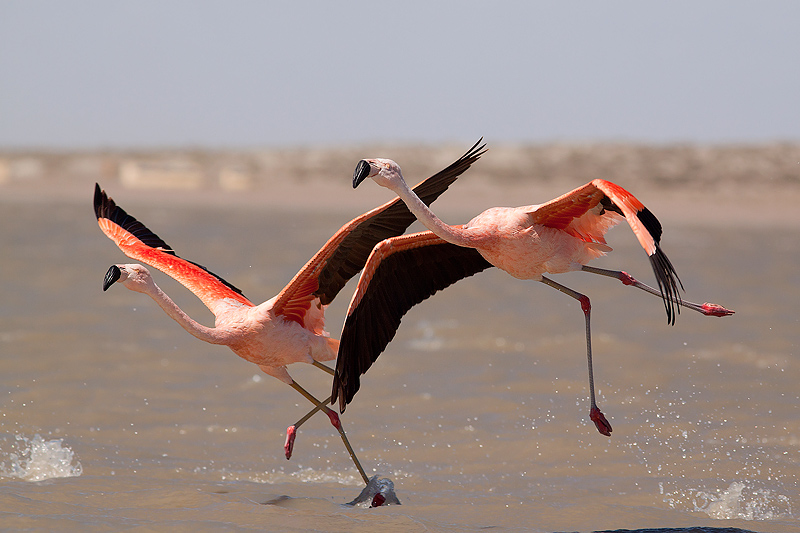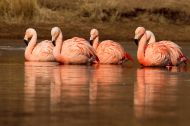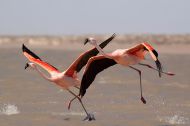Chilean Flamingo
Flamenco Austral
Phoenicopterus chilensis
Length: 110mm. Sexes alike. Bill whitish pink with the outer half black; bare skin on lores and eyelids yellowish pink; iris pale yellow; head and neck up to a third of its length, white with soft pink; rest of neck and body entirely pink; upperside of wings and scapulars striated scarlet; upperside of tail whitish pink, undertail deeper pink; upperside of wings show scarlet coverts, primaries and secondaries black; underside of wing show scarlet underwing coverts and axillaries; remiges black; legs greyish green with scarlet joints, toes and interdigital webs.
Juveniles or immature have a grey and black bill; head, neck and underparts whitish grey washed with soft pink; upperparts whitish grey striated dark brown; wing coverts greyish brown with feathers fringed whitish and with soft pink wash; remiges and rectrices very dark brown; legs dark bluish grey.
The groups of adults that inhabit freshwater bodies for extended periods show the neck and body plumage almost entirely white. The bird’s large size and characteristic silhouette renders it unmistakable. Habitat and behaviour: Flamingos are common, very gregarious birds, shy and wary. They frequent ponds, rivers and sea coastlines; on continental water bodies they prefer salty waters, lacking emergent vegetation with soft muddy bottoms. It feeds by stirring up the lime of the bottom of shallow waters moving its head, which is invertedly submerged, also stirring mud with its feet and sieving plant and animal floating micro-organisms, using its bill that is equipped with fine horny lamellae and its tongue to suck and expel water. This species nests in large colonies and breeds in vast salt pans that are practically impossible to tread due to the sticky mud at the bottom. Nest is made of mud, cone- shaped, concave at the top; a single egg is laid, seldom two, white; both parents in charge of incubation and caring of chick. Eggs hatch 28-32 days later. Chicks are born with a heavy coat of down and leave the nest a few days after hatching; parents feed them by regurgitation; at birth, they have a straight bill and cannot feed on their own until after three weeks later, although adults feed them for up to two months, when they are ready to fly. On account of their shy nature, they are extremely wary of people or strong noises such as that made by airplanes. They can panic and leave their nesting grounds, letting their offspring die. Also, the amount of water available and other natural events account for the frequent changes in breeding grounds.
Range: widely distributed in the southern part of South America. They occur throughout Argentina. Very abundant in Patagonia, accidentals may reach Islas Malvinas.
Illustrated Handbook of the Birds of Patagonia
Kindless: Kovacs Family
|










